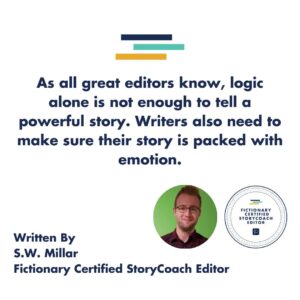
When editors talk about helping writers intensify the power of a story, what does that actually mean? What is it exactly that makes a story powerful, and how can we bring that power into our clients’ fiction?
Broadly speaking, there are two things editors need to consider if they want to help a writer boost the power of a story:
- Logic, and;
- Emotion.
Let’s take a look at each of these in turn before we examine how the Fictionary StoryCoach software for editors can help you advise your clients on how to weave logic and emotion into their stories to pack a powerful punch.
The Logical Power of a Story
When we’re helping our clients pen powerful stories, logic is a key component. After all, if a story isn’t logical (in terms of plot structure), then it’s foundations are fundamentally weakened.
When writers structure their stories according to logical, tried and tested story beats, the power of their stories increases exponentially.

Plot Beats and the Power of a story
Plot beats help writers tell stories in a logical way. Part of our roll as story editors is to guide writers and teach them how to structure a story, and the Fictionary Plot Beats are a great way to do that.
What are the Fictionary plot beats I hear you cry?
They are:
- The Inciting Incident: An event that dramatically changes the protagonist’s everyday world and where they first meet the central story conflict.
- Plot Point 1: Or the point of no return, where (after reacting to the Inciting Incident) the protagonist decides to engage in the central conflict.
- Middle/Midpoint: Where the protagonist shifts from reactive to proactive.
- Plot Point 2: Where something terrible happens to the protagonist (or something/someone they care about) and they have an “All is Lost” moment.
- The Climax: The scene(s) with the most tension and highest level of conflict, where the protagonist either achieves their goal (“happy” resolution), or fails (tragedy).
- The Resolution: Where the writer shows how much the protagonist has changed since the start of the novel.
Did we pluck these plot points out of the aether?
No!
We analysed all the trusted story arcs (from Jessica Brody’s Save the Cat Writes a Novel to K. M. Weiland’s Structuring Your Novel and even Aristotle’s Poetics) and we discovered all these structure templates share these five beats.
So it’s only logical to teach writers this structure, because it’s what readers expect, and really beefs up the power of a story.
How can the Fictionary StoryCoach Software Help with This?
The Fictionary StoryCoach software is a unique tool for editors because it gives you a ton of visual aids that help you see the writer’s entire novel at a glance and objectively evaluate the power of a story.
And one of the best features…?
The Fictionary Story Arc
The Fictionary Story Arc is a graph that shows the recommended plot beat placement for your client’s novel (blue line), and where your client has, placed those beats in their novel (yellow line).

As you fill out the 38 Story Elements on the Evaluate page (particularly the Scene Purpose Element), the story arc will adjust, so you can see the logical power of a story growing stronger as you edit.
You’ll agree this is a powerful tool.
But logic is only one side of the coin when it comes to the power of a story. What about emotion?
I’m glad you asked.
The Emotional Power of a Story
As all great editors know, logic alone is not enough to tell a powerful story. Writers also need to make sure their story is packed with emotion.
Emotion presents itself in multiple ways in fiction. Your characters will express emotion:
- After the Fictionary Story Beats: Take another peek at the Fictionary Story Beats, and you’ll notice that these key moments are going to have an effect on any protagonist. It stands to reason they’ll need to process emotion after these events have occurred.
- In certain Locations: If a writer has chosen their settings well, each should have an emotional impact on the protagonist or point of view character (e.g., having your protagonist’s relationship break down at their best friend’s wedding is more impactful than having it break down in some anonymous cafe they’ve never been to before).
- After experiencing a sensory trigger: The senses (sight, sound, smell, taste, and touch) are a key factor when triggering emotion (e.g., an army vet with PTSD who hears a car backfire is likely to have a huge emotional reaction because of their life experience).
This list isn’t exhaustive, but it gives you an idea of how helping writers express emotion in a way that’s authentic to their protagonist contributes to bolstering the power of a story.

How can the Fictionary StoryCoach Software Help with This?
There are multiple Fictionary Story Elements (which you’ll be analysing on the Evaluate page) that aid editors in strengthening the emotional power of a story.
The key story elements when evaluating the emotional flow of a story are:
- What if Goal Fails (Character Element): If a goal fails, then your client’s protagonist will (naturally) need to express emotion.
- Action/Sequel (Plot Element): Sequel scenes are where protagonists express emotion. Has your client got the right balance of action and sequel scenes for their genre?
- Emotional Impact (Setting Element): Has your client chosen settings that have an emotional impact on their protagonist.
Conclusion
The Fictionary StoryCoach Software helps editors ensure their clients leverage the power of a story through logic and emotion, and the visual aids (like the Fictionary Story Arc) are invaluable in this endeavour.
Want more on becoming a Fictionary Certified StoryCoach?
Read this article next: Why I Enrolled in the Fictionary Certified StoryCoach Program.
Article Written by Shane Millar

Shane Millar is a Fictionary Certified Story Coach and the author of the Write Better Fiction craft guides. He is also the author of the Myth & Magic and Chosen Vampire urban fantasy thriller series.
Shane holds a BA in journalism and is a member of The Alliance of Independent Authors (ALLi). He lives in Buckinghamshire, England.
He has taken too many writing courses to count and enjoys reading as much as possible. Shane is obsessed with five things: the writing craft, mythology, personal development, food, and martial arts movies.
Want to hire Shane to edit your novel? Visit: https://swmillar.com/editing
Want to be part of a writing and editing community with kindness at its heart?
Do you know about the free Fictionary community? We’re connecting writers and editors who all speak the same story editing language.
You’re most welcome to join.
- Connect with other writers and editors
- Get your editing questions answered by Fictionary Certified StoryCoach editors
- Access free, live editing classes presented by editing experts
- Learn about all things Fictionary: product updates, videos, webinars, best practices


